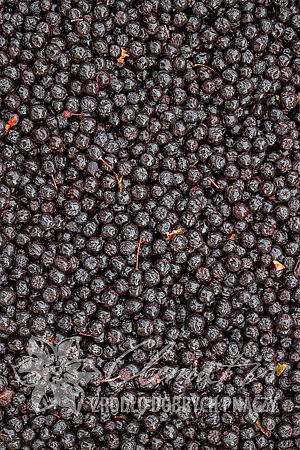Aronia ×prunifolia ‘Viking’
Purple Chokeberry 'Viking'| 装饰形式 | leaves which turn red in autumn, edible fruits |
|---|---|
| 花色 | white |
| 花期 | IV |
| 年生长量 | 0.5-0 m |
| 种植方位 | sun, 3/4 sun, 1/2 sun |
| 耐寒区 | Zones 4 - 7 |
| 1m2的密度 | 1 |
| 常绿植物 | no |
A fruit shrub of decorative leaves which turn spectacular red in autumn. The fruit of the cultivar is quite large, round, dark navy blue, gathered in clusters. Ideally suited for house gardens as well as for plantations.
WHAT IT LOOKS LIKE: Berries round, dark navy blue, large – 1.3-1.5 cm across, glossy, tasty, sour-sweet with a subtle bitter aftertaste, juicy; ripening in August-September, depending on the weather. Smallish melliferous white blossom gathered in corymbs. Blooming in May on old wood. Leaves decorative, dark green and glossy in vegetation season; in autumn turn red, yellow or purple.
HOW IT GROWS: Shrub of an upright habit the shape of an upside-down cone. The cultivar is more compact than the average of the species. Fast-growing, reaches 2.5 m height. Annual growth rate ca. 0.5 m.
WHERE TO PLANT: Yields fruit best when planted in a sunny site and in well-drained soil of neutral or slightly acidic pH, but it’s a tolerant plant. Does not require acidifying of the soil, as opposed to highbush blueberry. A healthy cultivar, unsusceptible to diseases and pest. Fully frost hardy (zone 4-7).
HOW TO PLANT AND MAINTAIN: Before planting immerse the plant container in water for 10-30 min. Place the root ball in a 40 x 40 x 40 cm hole with a 10 cm layer of well-rotten manure or compost, 0.5-1 cm deeper than it was before. Fill the hole with fertile soil. On plantations, the required plant spread is 0.5-0.7 x 4 m for mechanical harvesting purpose. Does not require regular pruning. When the bushes thicken after a couple of years, a thinning may be necessary. Excessive pruning limits the fruition.
HOW TO APPLY: The shrub recommended for amateur cultivation in house gardens as well as for plantations (also organic ones). Suitable also for landscape shaping as a hedge and for erosion control or as a field border – the berries are a source of food for many birds. The fruits are rich in vitamins (vitamin C especially), minerals and anti-oxidants. They are used for juice, syrup, jam and tincture production. They have anti-inflammatory and anti-bacterial properties and contribute to stable glucose levels.
ORIGIN: Most probably native to Russia.







